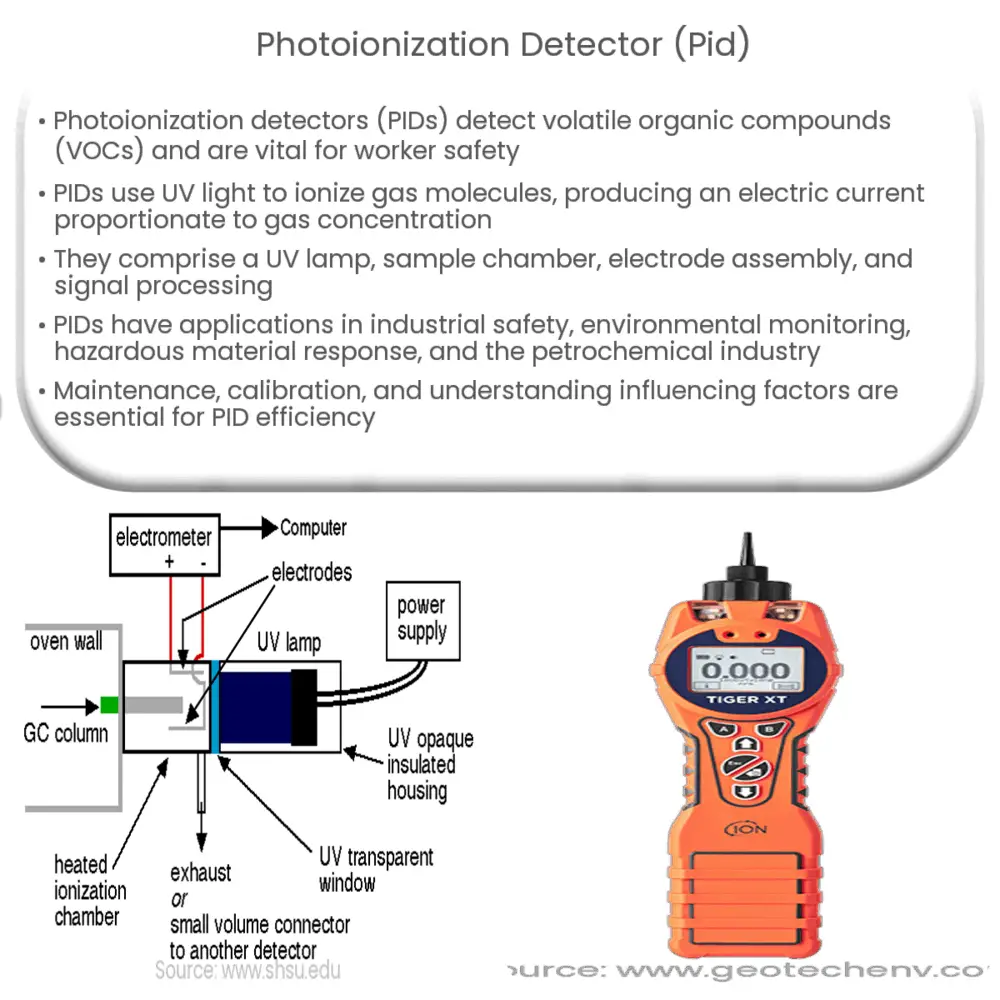A photoionization detector (PID) is a device that detects volatile organic compounds and toxic gases using ultraviolet light for ionization.

Understanding Photoionization Detectors (PIDs): An Essential Tool for Gas Detection
Introduction
Photoionization detectors (PIDs) are widely used in various industries for the detection and measurement of volatile organic compounds (VOCs) and other toxic gases. These instruments play a crucial role in ensuring the safety of workers and the environment. In this article, we will explore the principles behind PIDs, their applications, and the factors that influence their performance.
Principle of Operation
A photoionization detector operates by exposing the target gas to ultraviolet (UV) light, which ionizes the gas molecules. The ionization process generates positively charged ions and negatively charged electrons. By applying an electric field, the detector collects these charged particles, producing an electric current that is proportional to the concentration of the target gas. PIDs are highly sensitive, with detection limits typically in the parts per billion (ppb) range, making them ideal for low-concentration gas detection.
Components of a PID
A typical PID comprises several key components, including:
- UV Lamp: The UV lamp is the light source that ionizes the gas molecules. Different lamp types, such as mercury vapor or krypton, produce different energy levels, affecting the range of detectable compounds.
- Sample Chamber: This is where the target gas is introduced and exposed to the UV light. The sample chamber’s design is crucial in ensuring efficient ionization and preventing interferences from other gases or particles.
- Electrode Assembly: The electrode assembly is responsible for generating an electric field that collects the charged particles produced during ionization. The magnitude of the electric current generated is proportional to the concentration of the target gas.
- Signal Processing: The electric current is amplified and processed by the PID’s electronics to provide a concentration reading, typically displayed in ppm or ppb.
Applications of PIDs
Photoionization detectors have a wide range of applications across various industries, some of which include:
- Industrial Hygiene and Safety: PIDs are commonly used to monitor VOCs and other toxic gases in workplaces, ensuring compliance with occupational exposure limits and maintaining a safe working environment.
- Environmental Monitoring: PIDs help assess air quality by measuring concentrations of hazardous gases and VOCs in the environment. They are also used in soil and water contamination assessments.
- Hazardous Material Response: Emergency responders use PIDs to detect and identify hazardous substances during spills, leaks, or other incidents.
- Petrochemical Industry: PIDs are used in refineries, chemical plants, and storage facilities to monitor for gas leaks and ensure process safety.
Factors Influencing PID Performance
Several factors can impact the performance of a photoionization detector, including:
- Ionization Potential: Each gas has a unique ionization potential (IP), which is the minimum energy required to ionize a molecule. The UV lamp’s energy output must be equal to or greater than the target gas’s IP for successful detection. As a result, selecting the appropriate lamp is crucial for accurate PID operation.
- Interfering Gases: Certain gases can interfere with the ionization process, leading to false readings or reduced sensitivity. To minimize interference, sample conditioning or selective filtering may be necessary.
- Humidity: High levels of humidity can affect the ionization process and lead to reduced sensitivity or inaccurate readings. Some PIDs have built-in humidity compensation to mitigate this issue.
- Temperature: PIDs are sensitive to temperature fluctuations, which can affect both the UV lamp and the electronics. Temperature compensation is often built into the detector to maintain accuracy and stability.
- Calibration: Regular calibration with known gas concentrations is essential to maintain PID accuracy and reliability. Calibration frequency depends on the application and environmental conditions.
Maintenance and Troubleshooting
Proper maintenance is crucial for ensuring the optimal performance and longevity of a PID. Some common maintenance tasks include:
- UV Lamp Replacement: Over time, the output of the UV lamp may degrade, reducing the detector’s sensitivity. Regularly checking the lamp output and replacing it when necessary is crucial for maintaining accurate detection.
- Electrode Cleaning: The electrode assembly can become contaminated with dust, dirt, or other particulates, leading to reduced sensitivity. Periodic cleaning is essential to maintain optimal performance.
- Calibration: As previously mentioned, regular calibration is vital to ensure accurate and reliable operation.
When troubleshooting a PID, common issues include poor sensitivity, erratic readings, or no response. These issues may be caused by a malfunctioning UV lamp, dirty electrodes, or incorrect calibration. Identifying and addressing these issues is critical for maintaining PID performance.
Conclusion
Photoionization detectors are indispensable tools for detecting and measuring volatile organic compounds and other toxic gases in various industries. Understanding the principles behind PIDs, their applications, and factors affecting their performance is essential for effective gas detection and ensuring workplace safety and environmental compliance. Proper maintenance, calibration, and troubleshooting are crucial for maintaining the accuracy and reliability of these critical instruments.

